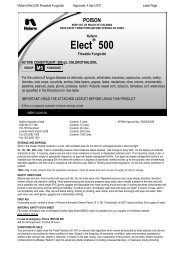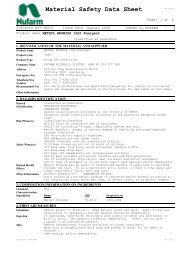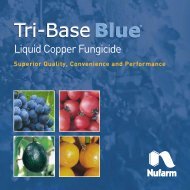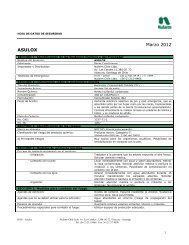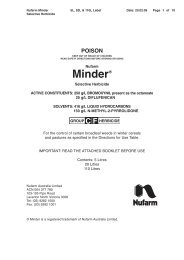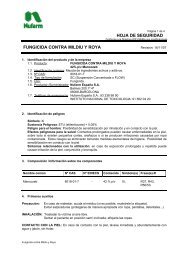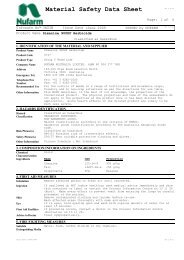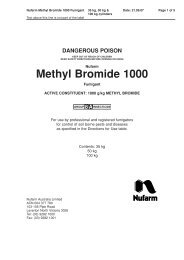MSDS - Nufarm
MSDS - Nufarm
MSDS - Nufarm
You also want an ePaper? Increase the reach of your titles
YUMPU automatically turns print PDFs into web optimized ePapers that Google loves.
Material Safety Data Sheet<br />
CS: 1.4.21<br />
Page: 2<br />
of<br />
6<br />
CS: 1.4.21<br />
Infosafe No NU00W Issue Date : July 2009 ISSUED by NUFARM<br />
Product Name CHLORPYRIFOS 500EC Insecticide<br />
Classified as hazardous<br />
of Health and Ageing via the National Drugs and Poisons Schedule. These<br />
instructions are suitable for ingestion of spray solution and small amounts of<br />
concentrate; however, if SUBSTANTIAL AMOUNTS of the concentrate have been<br />
swallowed (more than about one teaspoon) AND if medical assistance is more<br />
than 30 minutes away, the induction of vomiting should be CONSIDERED,<br />
preferably based on MEDICAL ADVICE if a physician can be contacted by phone.<br />
All care must be taken to prevent vomit from being inhaled. Do not give<br />
anything by mouth to a semi-conscious or unconscious person.<br />
Skin<br />
If skin contact occurs, remove contaminated clothing and wash skin thoroughly<br />
with water.<br />
Seek medical advice, but only after the exposed skin has been thoroughly<br />
washed.<br />
Eye<br />
If in eyes, hold eyelids open and wash with copious amounts of water for at<br />
least 15 minutes.<br />
Seek medical advice.<br />
First Aid Facilities If poisoning occurs, contact a doctor or the Poisons Information Centre<br />
(Australia) on 13 11 26.<br />
Advice to Doctor An anticholinesterase compound.<br />
If the material is dissolved in solvents, e.g., petroleum solvents, vomiting<br />
may cause pulmonary aspiration. Instead, the stomach should be emptied as soon<br />
as possible by careful gastric lavage (using a cuffed endotracheal tube<br />
already in place). Artificial respiration should be started at the first sign<br />
of respiratory failure. Cautious administration of fluids is advised, as well<br />
as general supportive and symptomatic pharmacological treatment and absolute<br />
rest. As early as possible, administer 2 mg of atropine sulfate i.v. and<br />
1000-2000 mg of pralidoxime chloride or 250 mg of obidoxime chloride (adult<br />
dose) i.v. to patients suffering from severe respiratory difficulties,<br />
convulsions, and unconsciousness. Repeated doses of 2 mg of atropine sulfate<br />
should be given, as required, based on the respiration, blood pressure, pulse<br />
frequency, salivation, and convulsion conditions. The dose and the frequency<br />
of atropine varies with each patient, but the patient should remain fully<br />
atropinised (signs include dilated pupils, dry mouth, skin flushing).<br />
Diazepam should be given in all but the mildest cases in doses of 10 mg, s.c.<br />
or i.v., which may be repeated as required. For children, the doses are<br />
0.04-0.08 mg of atropine/kg body weight, 250 mg of pralidoxime chloride per<br />
child, or 4-8 mg of obidoxime chloride/kg body weight. Morphine, barbiturates,<br />
phenothiazine derivatives, tranquillizers, and all kinds of central stimulants<br />
are contraindicated.<br />
5. FIRE FIGHTING MEASURES<br />
Suitable<br />
Water fog, foam, carbon dioxide or dry chemical.<br />
Extinguishing Media<br />
Hazards from<br />
Combustion<br />
Products<br />
Special Protective<br />
Equipment for fire<br />
fighters<br />
Hazchem Code<br />
Emergency Action in<br />
case of Fire<br />
Other Information<br />
May emit toxic fumes of hydrogen chloride or phosgene if involved in fires or<br />
exposed to extreme heat.<br />
Breathable air apparatus may have to be worn if material is involved in fires<br />
especially in confined spaces.<br />
2X<br />
If exposed to fire, keep container cool by spraying with water.<br />
STOP FIRE WATER FROM ENTERING DRAINS OR WATER BODIES.<br />
6. ACCIDENTAL RELEASE MEASURES<br />
Spills & Disposal Contain spill and absorb with clay, sand, soil or proprietary absorbent (such<br />
as vermiculite).<br />
Collect spilled material and waste in sealable open-top type containers for<br />
disposal.<br />
Dispose of at a landfill in accordance with local regulations.<br />
If possible, ring 1800 033 498 for specialist advice.<br />
Personal Protection For appropriate personal protective equipment (PPE), refer Section 8.<br />
Print Date: 23/07/2009 CS: 1.4.21



